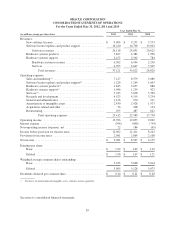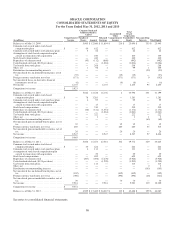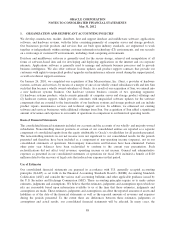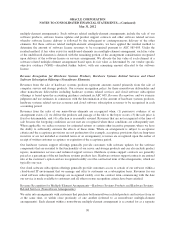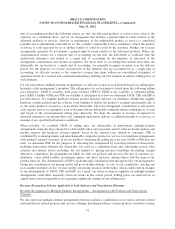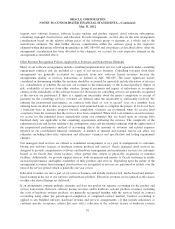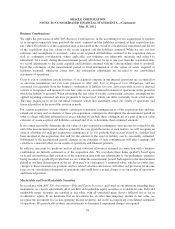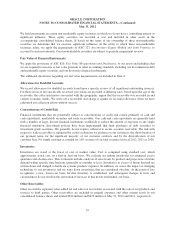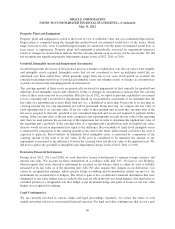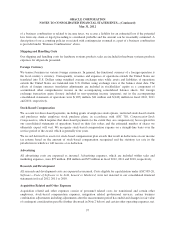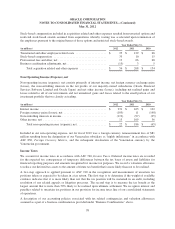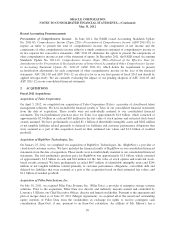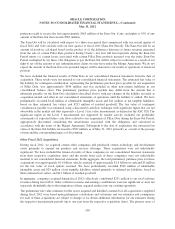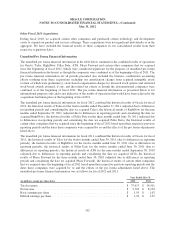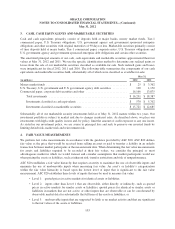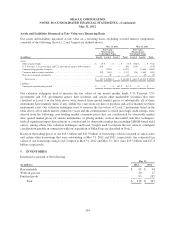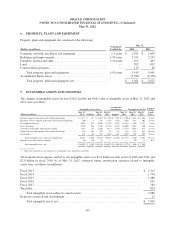Oracle 2012 Annual Report Download - page 99
Download and view the complete annual report
Please find page 99 of the 2012 Oracle annual report below. You can navigate through the pages in the report by either clicking on the pages listed below, or by using the keyword search tool below to find specific information within the annual report.ORACLE CORPORATION
NOTES TO CONSOLIDATED FINANCIAL STATEMENTS—(Continued)
May 31, 2012
We hold investments in certain non-marketable equity securities in which we do not have a controlling interest or
significant influence. These equity securities are recorded at cost and included in other assets in the
accompanying consolidated balance sheets. If based on the terms of our ownership of these non-marketable
securities we determine that we exercise significant influence on the entity to which these non-marketable
securities relate, we apply the requirements of ASC 323, Investments—Equity Method and Joint Ventures,to
account for such investments. Our non-marketable securities are subject to periodic impairment reviews.
Fair Value of Financial Instruments
We apply the provisions of ASC 820, Fair Value Measurements and Disclosures, to our assets and liabilities that
we are required to measure at fair value pursuant to other accounting standards, including our investments in debt
and marketable equity securities and our derivative financial instruments.
The additional disclosures regarding our fair value measurements are included in Note 4.
Allowances for Doubtful Accounts
We record allowances for doubtful accounts based upon a specific review of all significant outstanding invoices.
For those invoices not specifically reviewed, provisions are provided at differing rates, based upon the age of the
receivable, the collection history associated with the geographic region that the receivable was recorded in and
current economic trends. We write-off a receivable and charge it against its recorded allowance when we have
exhausted our collection efforts without success.
Concentrations of Credit Risk
Financial instruments that are potentially subject to concentrations of credit risk consist primarily of cash and
cash equivalents, marketable securities and trade receivables. Our cash and cash equivalents are generally held
with a number of large, diverse financial institutions worldwide to reduce the amount of exposure to any single
financial institution. Investment policies have been implemented that limit purchases of debt securities to
investment grade securities. We generally do not require collateral to secure accounts receivable. The risk with
respect to trade receivables is mitigated by credit evaluations we perform on our customers, the short duration of
our payment terms for the significant majority of our customer contracts and by the diversification of our
customer base. No single customer accounted for 10% or more of our total revenues in fiscal 2012, 2011 or 2010.
Inventories
Inventories are stated at the lower of cost or market value. Cost is computed using standard cost, which
approximates actual cost, on a first-in, first-out basis. We evaluate our ending inventories for estimated excess
quantities and obsolescence. This evaluation includes analysis of sales levels by product and projections of future
demand within specific time horizons (generally six months or less). Inventories in excess of future demand are
written down and charged to hardware systems products expenses. In addition, we assess the impact of changing
technology to our inventories and we write down inventories that are considered obsolete. At the point of loss
recognition, a new, lower-cost basis for that inventory is established, and subsequent changes in facts and
circumstances do not result in the restoration or increase in that newly established cost basis.
Other Receivables
Other receivables represent value-added tax and sales tax receivables associated with the sale of our products and
services to third parties. Other receivables are included in prepaid expenses and other current assets in our
consolidated balance sheets and totaled $812 million and $876 million at May 31, 2012 and 2011, respectively.
95


